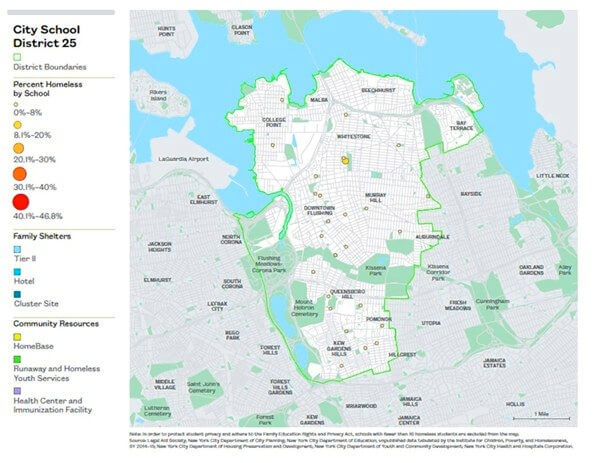By Patrick Donachie
School districts in Queens varied in terms of the numbers of students who experienced homelessness in the 2014-15 school year, according to a new report released by a nonprofit.
“On the Map: The Atlas of Student Homelessness,” released by the Institute for Children, Poverty and Homelessness, measured a wide array of markers for New York students who were homeless, including the number of students who had received Individual Education Plans late, the number of English language learners and the suspension rates for homeless students.
“With more and more children experiencing homelessness, it is vitally important to understand the unique challenges that homeless students face and the interventions and opportunities available to meet their needs,” the executive summary of the report read.
District 25, which includes Flushing and Whitestone and District 26, which includes Bayside, Little Neck, Fresh Meadows and Floral Park, had the lowest student homeless rates of any school districts in the city. District 29, which includes Hollis and Queens Village, had the highest homeless student population of any district in Queens, although it was only the 19th highest percentage per district in the city out of 32 districts.
According to the report, District 29 includes 462 shelter units and four family shelters, while Districts 25 and 26 do not include any. However, students living in a certain shelter may not necessarily attend school in that same district.
Other Queens district fared somewhat better than District 29. District 30, which includes Astoria and Long Island City, ranked 23 out of 32 districts measuring percentage of students who were homeless, while District 24, which includes Sunnyside, Ridgewood, Elmhurst and Corona, was listed as the district with the 24th highest rate. District 28, which includes Rego Park, Forest Hills and Briarwood, and District 27, which includes Woodhaven, Ozone Park and Howard Beach, were ranked 27 and 28, respectively.
Citywide, the analysis found that one out of every eight students enrolled in a city public school in the 2014-15 year had experienced homelessness in the past five school years. It found that if all the students who experienced homelessness were included in their own district, it would be of a comparable size to the unified district of San Diego, Calif., and greater than unified districts in Seattle and Boston.
The study also concluded that sections of the Bronx suffer most acutely from student homelessness. Nearly 20 percent of homeless city public school students were enrolled in schools in Districts 9 and 10, which included the Highbridge and Fordham areas in the Bronx.
The full report is available online at www.icphu
Reach reporter Patrick Donachie by e-mail at pdona































